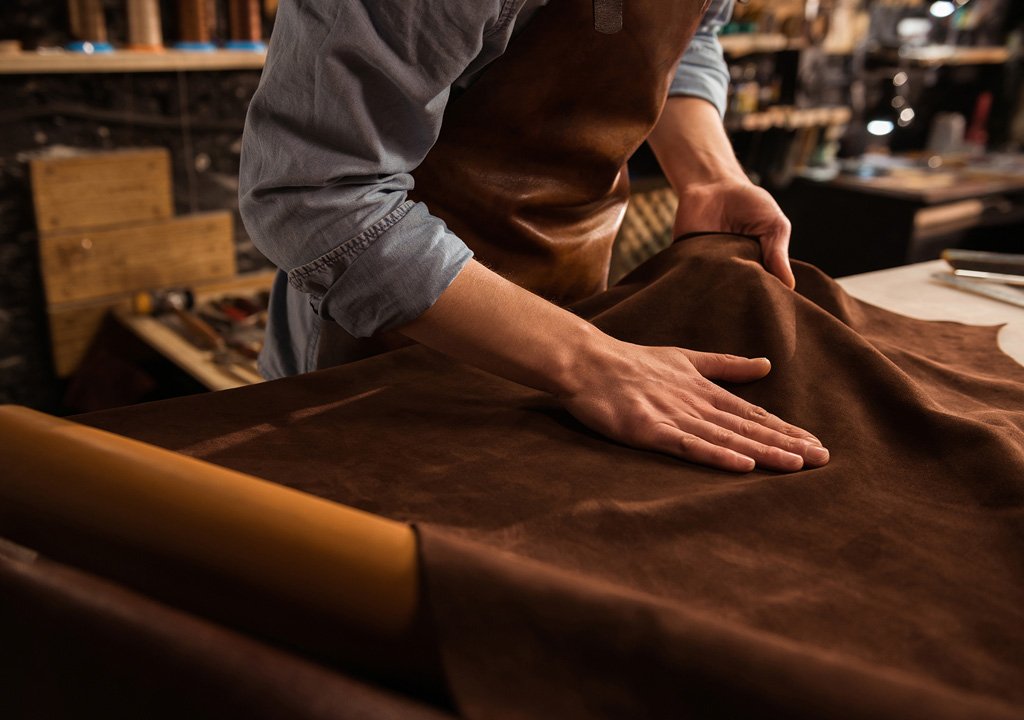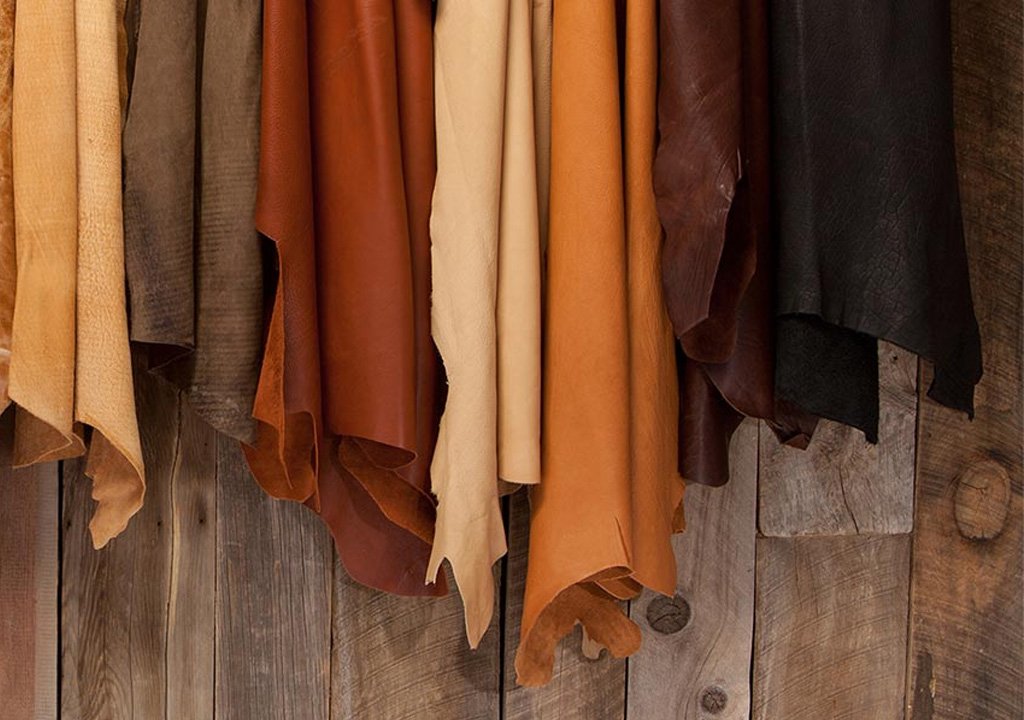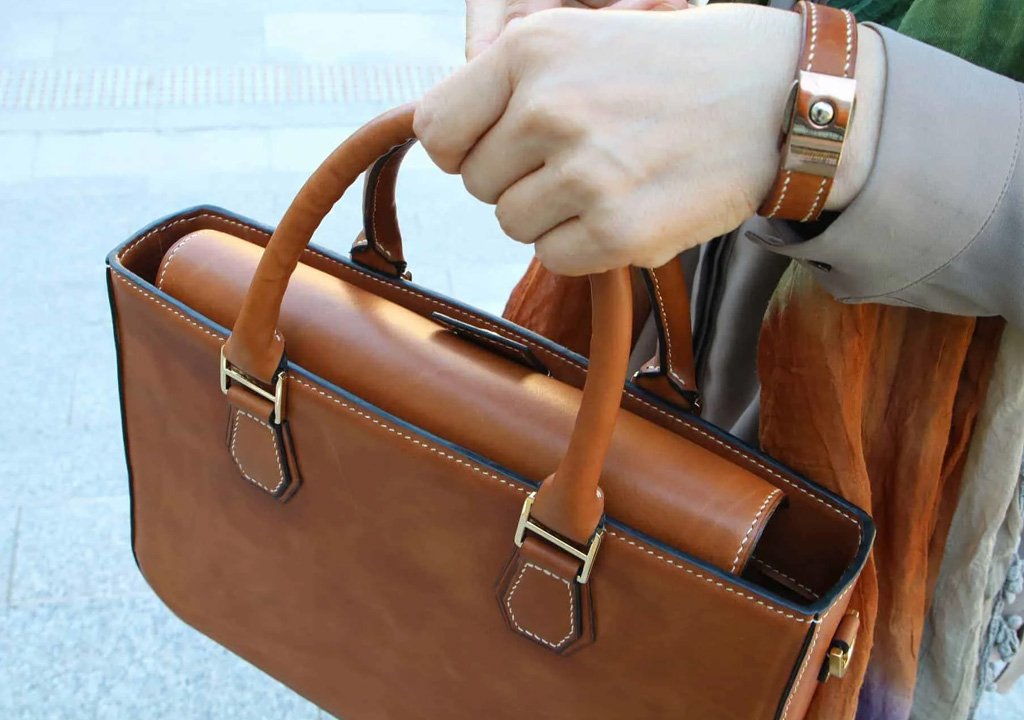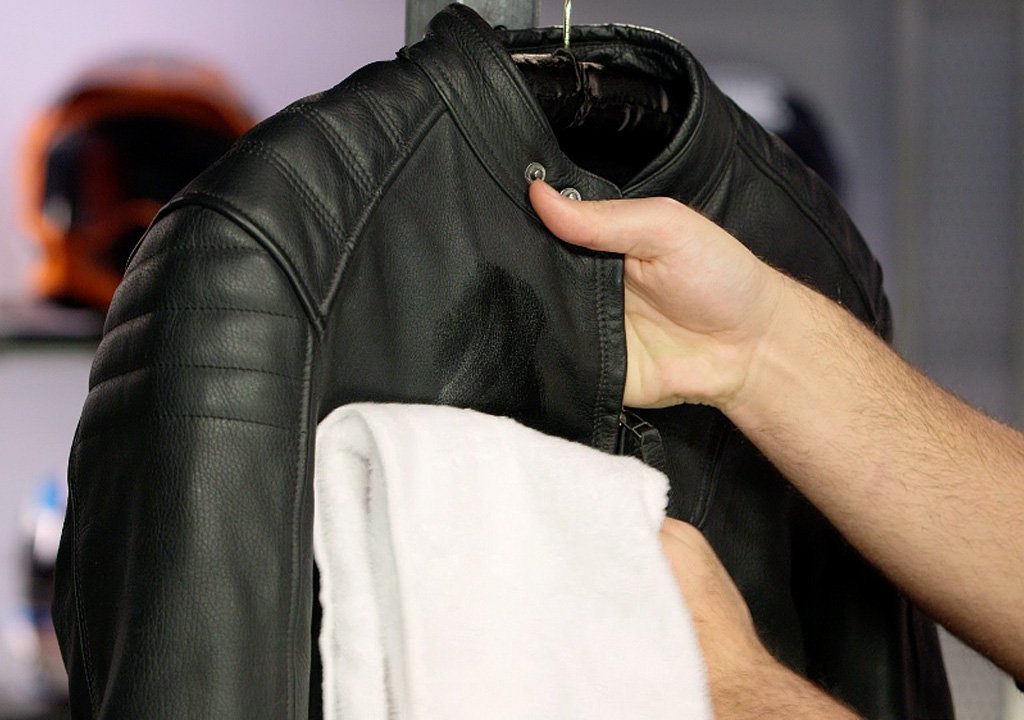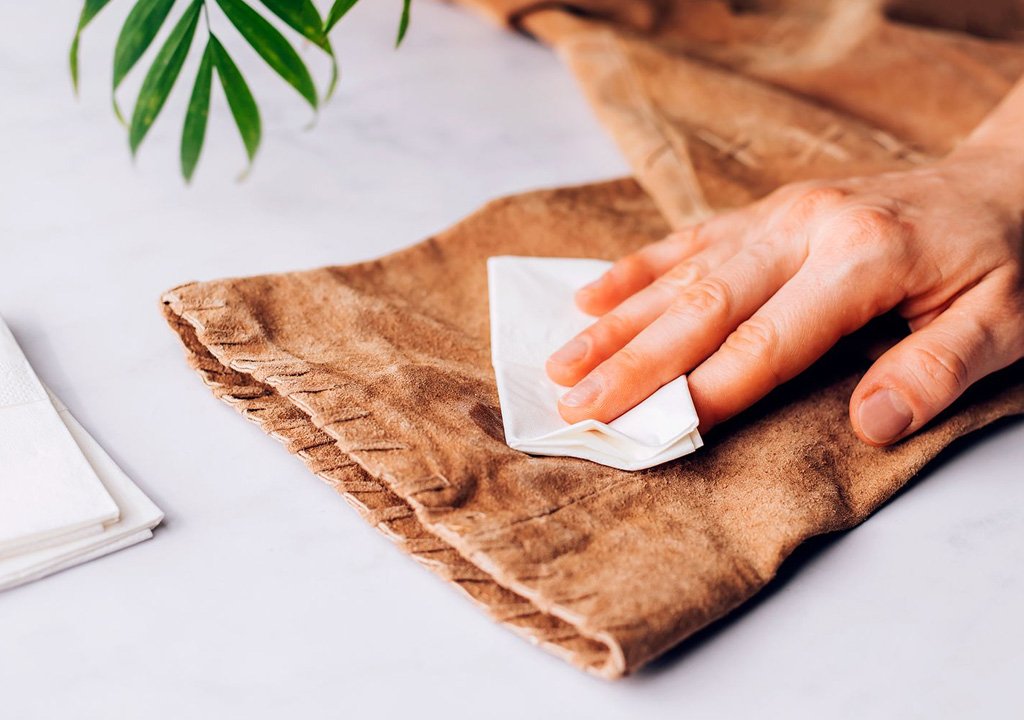Full grain leather comes from the strongest and most durable part of an animal’s hide, just beneath the hair, and it retains its natural characteristics without sanding or buffing (unlike corrected grain leather). This type of leather maintains its grain surface, resulting in increased fiber strength and durability. Over time, full grain leather develops a unique patina. An aniline finish, often found on full grain leather, involves staining or dyeing the leather while preserving its natural grain. This finish allows the leather to breathe and showcases its natural beauty. Compared to other leathers that are sanded and coated, full grain leather is considered the highest quality due to its authenticity and durability, making it a preferred choice for our bags and accessories.
What Does Full Grain Leather Look Like?
Full grain leather proudly displays its natural markings and imperfections, which many believe contribute to its distinct character.
As the strongest and outermost layer of the hide, full grain leather retains its complete grain structure rather than being sanded down for uniformity. This preservation of the grain contributes to its exceptional durability and longevity. Over time, full grain leather develops a patina, a desirable change in color that occurs more rapidly in untreated pieces.
Upon close inspection, the smooth, unaltered surface of full grain leather reveals pores and small hair follicles, indicating its high quality. Notable features include fat wrinkles, growth lines, variations in grain texture, shading, and minor scars.
Each hide is unique due to the individual markings and blemishes of the animal it comes from. Therefore, when working with full grain leather, you’ll discover that no two hides are exactly alike.
What Does Full Grain Leather Upper Mean?
Full grain leather uppers refer to the upper portion of footwear, such as boots or shoes, that is crafted from full grain leather. The term “leather upper” specifically pertains to the part above the sole, encompassing the entire area made from leather.
Where Does Full Grain Leather Come From?
Full grain leather is derived from the layer of skin located beneath the hair and is extracted from the outermost part of the hide. Due to its tightly interlinked fiber structure, it boasts exceptional durability. While full grain leather can originate from a range of animals including goats, pigs, sheep, and exotic creatures like alligators, ostriches, and kangaroos, cattle skin is the most prevalent choice for leather production. Our website exclusively offers full grain leather products sourced solely from cow hides. For additional information on our hide sourcing practices, feel free to explore further.
How is Full Grain Leather Made?
Leather production involves three primary stages: preparation, tanning, and crusting. A potential fourth step entails applying a surface coating or finish to the leather.
Preparation:
The leather production process begins with preparation of the animal skin or hide. This involves several steps:
- Preservation and Treatment: The hide is treated to temporarily preserve it and make it resistant to decay.
- Soaking: The hide is soaked to clean and rehydrate it, making it more pliable for further processing.
- Liming: The hide is soaked in an alkaline solution to remove proteins, natural fats, and greases.
- Hair Removal: The hair is removed from the skin.
- Fleshing: Subcutaneous materials and fat are removed from the hide’s underside.
- Splitting: The hide is divided into layers, such as the top layer (full grain) and the corium layer used for “genuine” leather and suede.
- Further Processing: The hide undergoes processes like bating to soften the pelt, slicking to remove fat, bleaching, and pickling (lowering pH) to prepare it for tanning agents.
These steps lay the foundation for the subsequent tanning and crusting stages in leather production.
Tanning:
After preparation, the hide undergoes the tanning process to transform it into a stable and flexible material that resists decay. Tanning ensures that the leather dries out without deteriorating. Different tanning methods are employed based on the leather’s intended use. The most common tanning agent is Chromium. However, we exclusively use vegetable dyes that are Chrome VI-free for our leather.
During tanning, hides are placed in drums with tanning liquor and rotated slowly for even penetration. Once sufficient penetration is achieved, the pH levels are gradually increased through basification. Basification fixes the tanning material onto the leather fibers, completing the tanning process.
Crusting:
Following tanning, the tanned hides enter the crusting phase, which involves thinning, additional tanning, and lubrication. Crusting is also the stage where coloring is often applied. The primary goal of crusting is to dry and soften the hides.
Leather may also undergo a surface coating or finishing process, which includes:
- Oiling
- Brushing
- Padding
- Spraying
- Buffing
- Embossing
- Glazing
These operations are conducted based on the leather’s requirements. For instance, patent leather receives an ultra-glossy, shiny finish.
Where to Buy Full Grain Leather
Full grain leather is readily available for purchase from tanneries, leather merchants, and online stores globally. The top eight leather-producing countries are the USA, Argentina, South Korea, Pakistan, Russia, Italy, Brazil, and China. In alignment with our brand, all the full grain leather utilized in creating Vogue Jackets originates from Pakistan.
What is Pebbled Leather?
Pebbled leather refers to leather that has undergone a process to emboss a textured, pebbled pattern onto its surface. This texturing is primarily done for aesthetic purposes and helps to conceal any natural imperfections present on the leather’s surface.
What is Burnished Leather?
Burnishing is a finishing technique in which pressure and friction are applied to leather, resulting in a smoother texture and a darker, more antiqued color. This technique is commonly used on leather edges, often utilizing a metal tool like a spinning disk to achieve the desired effect.
What is Oiled Full Grain Leather?
Oiled leather is treated with oils like raw or a combination of raw and emulsified oils, along with a penetrating aid. This hydrates the leather, providing flexibility, lubrication, and water resistance. Oiled leather is commonly used with full grain aniline leathers.
What is Tumbled Full Grain Leather?
Tumbling is a method used to soften and treat leather. It involves placing the leather in a drum to create a smoother surface and enhance the grain pattern.
How to Maintain Full Grain Leather?
Full grain leather is relatively low maintenance. Wipe it with a cloth periodically to prevent dust and dirt buildup. Proper storage is key – avoid heat sources and humidity extremes. Store it in a controlled environment (40-50% humidity) to maintain moisture. Use leather cleaning, waterproofing, and conditioning products to preserve its quality. Some products can alter leather color, so patch test before applying. Conditioning helps prevent stiffness and drying. Avoid using radiators or hair dryers on leather. Embrace natural aging, or use appropriate products to keep it soft and supple.
How to Protect Full Grain Leather?
Leather protectants and sealants provide a barrier to prevent natural oils and moisture from escaping, keeping the leather supple. Applying polish is a personal choice and can offer added protection against dirt and grease. It creates an additional barrier on the leather’s surface.
How to Waterproof Full Grain Leather?
Leather is not completely waterproof due to its permeable nature. To enhance waterproofing, oiling your full grain leather is recommended. Beeswax or spray protectors can also be used, but always test on an inconspicuous area first to avoid color changes. If leather gets wet, avoid using a radiator or hair dryer, as it can dry out the leather.
How Long Does Full Grain Leather Last?
Full grain leather is highly durable, often lasting 5 times longer than fabric. With proper care and usage, it can endure for decades.
How Thick is Full Grain Leather?
The thickness of full grain leather varies based on its manufacturing method and intended use. Tanned hides are often split into multiple layers, which affects thickness. The strength of full grain leather is derived from its tightly woven fiber structure rather than its thickness. Lower cuts of leather have a looser fiber structure and are less durable.
Full Grain Leather Versus Corrected Leather
Full grain leather retains the outermost layer of the hide, displaying natural blemishes. In contrast, corrected grain leather undergoes buffing and sanding to eliminate blemishes like scars or insect bites, resulting in a smoother appearance. Corrected grain is then stamped or embossed with an artificial grain pattern. Despite its uniform look, corrected grain leather is of lower quality, often appearing more plastic-like.
Kangaroo Leather
Kangaroo leather, often utilized for making shoes, soccer cleats, laces, and whips, has distinct fiber structure compared to cowhide. It is split into thinner layers due to its original tensile strength and stretchiness. However, due to its thinness, kangaroo leather may not be as durable as full grain cowhide and lacks water resistance.
Calfskin Leather
Calfskin leather, obtained from younger animals, is smoother with fewer blemishes. It appears smooth with a fine grain, maintaining durability due to its tightly interwoven fiber structure. Calfskin retains shape well and is waterproof. However, its thinner and lighter nature compared to full grain cowhide makes it less durable.
Bonded or Blended Leather
Bonded or blended leather is produced using scraps of genuine leather, processed into sheets and fused together. Embossing adds an artificial grain. Considered low quality, it lacks durability compared to full grain leather. Unlike full grain, bonded leather doesn’t develop a patina and is hard to repair.
Full Grain/Top Grain Leather Versus Split
Hides are split into top/grain and split layers. The grain layer produces full grain, top grain, corrected grain, and nubuck leather, known for longevity and strength. Split leather, with a looser fiber structure, often imitates grain leather through printed textures. Suede is commonly made from split leather.
Full Grain Versus Genuine Leather
The term ‘genuine leather’ can mislead consumers, as it’s made from real leather but often of lower quality from split leather, weaker than full grain. People may mistake ‘genuine leather’ for good quality, but full grain leather, from the top hide layer, is considered higher quality.
Suede and Nubuck
Suede and nubuck leather are similar, with a velvety nap from abrasion, but nubuck is from grain leather and tougher, more water-resistant. Suede is from split layer, weaker, and has a coarser nap. Both are less durable and have a different feel and appearance compared to full grain leather.



